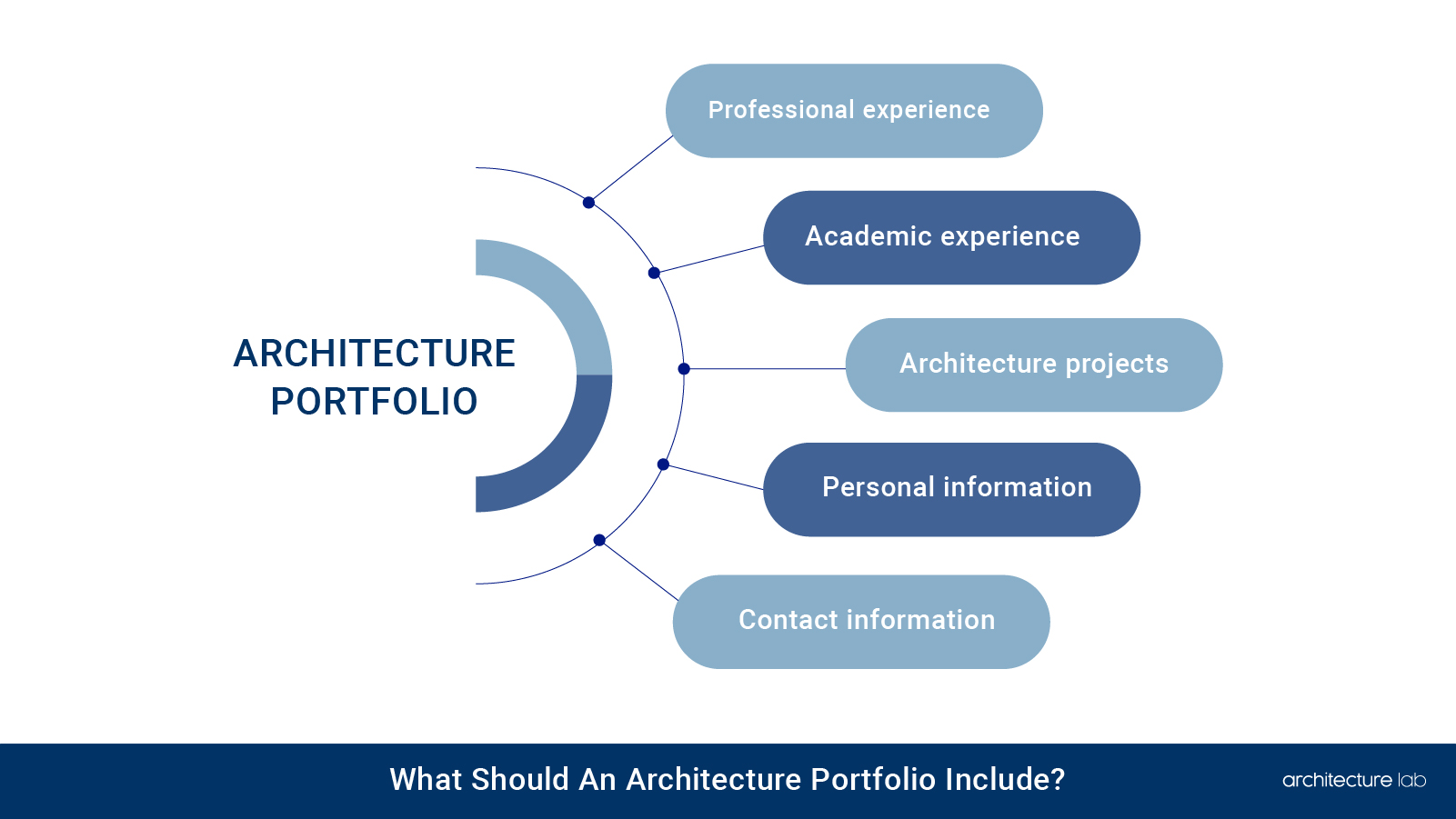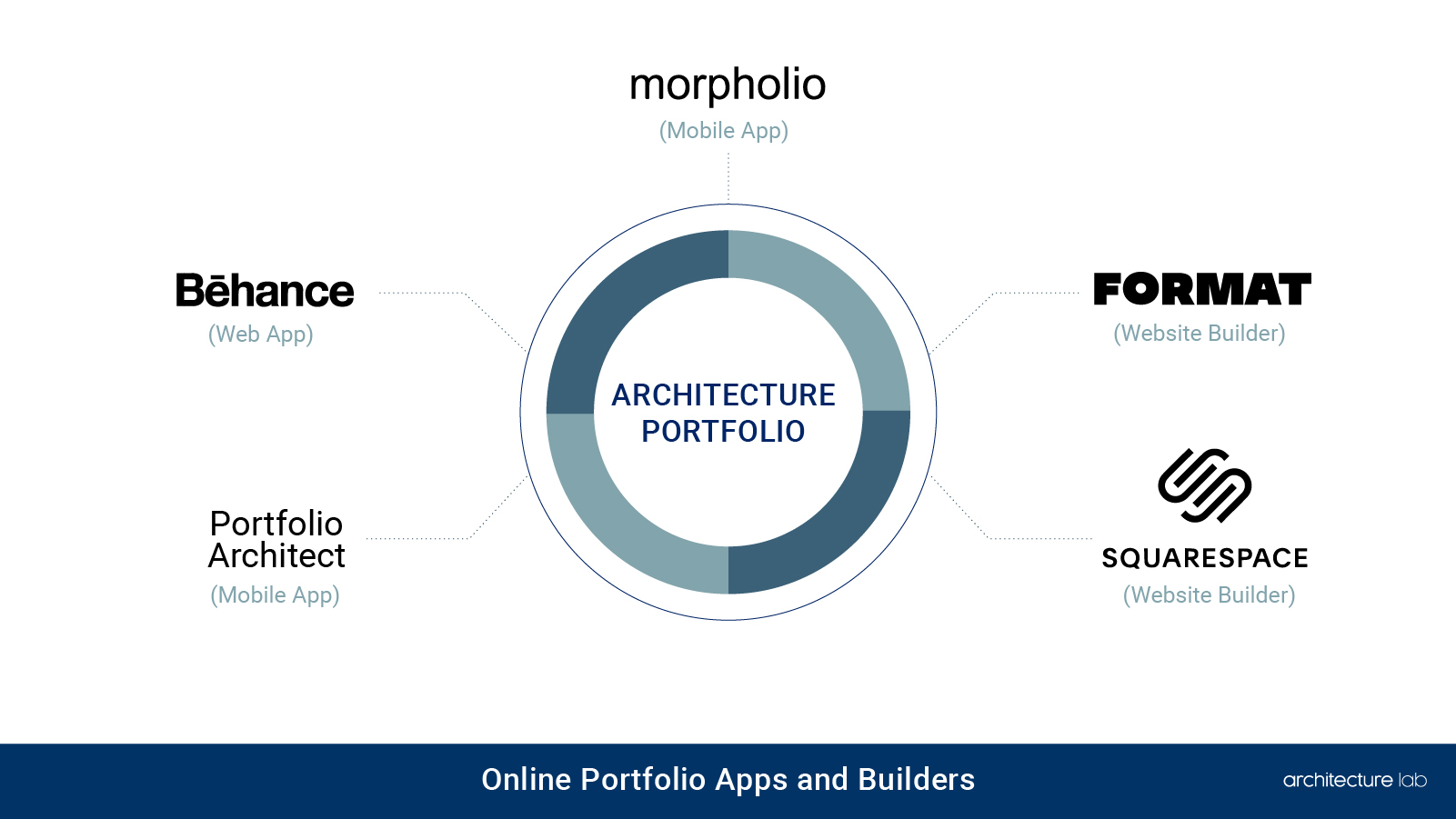An architecture portfolio is a collection of work showcasing an architect’s skills, experience, design philosophy, and capabilities. It includes high-quality images of key projects and information about the architect’s role and contributions. This visual format is essential for architects at any career stage and across all specialties to demonstrate their skills, style, and experience. It establishes their professional reputation and wins new projects and jobs. Portfolios reflect an architect’s professional journey and are crucial for continuous growth. A comprehensive portfolio should include professional and academic experiences, showcasing applied skills from architectural projects, academic works, and creative portfolio layouts. It should also have personal information and contact details to connect with potential employers or clients. To create a compelling portfolio, architects should showcase their best work, ensure a high-quality presentation, tell a coherent story, emphasize transferable skills, customize it for the target audience, keep it concise, show the design process, edit ruthlessly, perfect the presentation, and be authentic. Architects should use PDF portfolios for easy distribution, professional appearance, and consistent display quality. They’re accessible across platforms and devices, allowing simple sharing and retaining the intended presentation. Online portfolios are recommended for broader visibility and flexibility, are accessible on various tools, and incorporate dynamic features like video walkthroughs and 3D models. Paper portfolios suit architects valuing in-person interactions and tangible presentations, offering control over sequencing and layout and avoiding reliance on technology. Architects can create online portfolios using tools like Behance, Format, Morpholio, Squarespace, and Portfolio Architect. These tools offer various features like customizable templates, mobile accessibility, and integration with other professional tools, helping architects showcase their work in a digital format effectively.
What is an architecture portfolio?
An architecture portfolio is a work collection demonstrating an architect’s skills, experience, design philosophy, and capabilities. It showcases an architect’s best and most representative projects in a visual format. The portfolio aims to provide potential employers or clients with a comprehensive understanding of the architect’s talents and expertise. An effective portfolio will include high-quality images of key projects and relevant information about the architect’s specific role, responsibilities, and contributions to each project. The projects are organized and presented in a clear, logical format that allows viewers to quickly assess the architect’s talents and fit for available projects or positions.
Why do all types of architects need a portfolio?
A portfolio is a critical career tool for all types of architects at all levels – from interns to land that first job, to junior architects hoping to move up the ranks and take on more responsibility, to senior architects establishing a reputation and competing for major projects. Portfolios showcase skills, experience, design sensibilities, and professional growth through a carefully curated collection of project work. For interns and junior architects, it charts their trajectory from academic foundations to hands-on training to increasing capabilities. For seasoned professionals, an expansive portfolio reflects a multifaceted career arc. Regardless of career stage, portfolios enable architects to demonstrate their competencies and fit, making them indispensable for career advancement, client procurement, and continuous learning. Robust portfolios become calling cards for architects over the lifespan of their working lives.
What should an architecture portfolio include?

Listed below is what should be included in an architecture portfolio:
- Professional experience: Professional experience presentations demonstrate applied skills and knowledge from completed architectural projects for firms or clients. This includes work from the architect’s first job, which exhibits early career aptitude. Projects from later positions at different firms highlight versatility—academic projects completed as a professor spotlight theoretical capabilities and research skills. Annual reviews feature standout work from each year at a firm, illustrating professional growth. Integrating LinkedIn provides a digital presence.
- Academic experience: Academic experience adds critical context to an architect’s educational foundation. High school and early college creative works display raw potential for architecture programs. Strong undergraduate projects make a case for readiness for graduate study. Graduate school and doctoral research pieces showcase advanced academic ability. Academic essays, thesis, funded grant proposals, and other writings spotlight communication talent. Scholarships and awards validate accomplishments.
- Architecture projects: Architecture projects provide an overview of competencies. An archive of past work conveys range and diversity. Academic works exhibit developing skills and design style. Creative portfolio layouts and visuals highlight graphic abilities. Exercises in portfolio creation demonstrate initiative and engagement. It features an exemplary standalone project that spotlights specialized skills.
- Personal information: Personal information reveals personality and interests. These convey that architecture is a passion that expands beyond professional obligations. Relatives and friends may connect more with hobbies or talents like photography. A portfolio also catalogs career achievements and milestones, telling the story of accomplishments to date.
- Contact information: Contact information like name, email, phone number, and website links enables potential employers, clients, collaborators, and academic programs to follow up and contact the architect. This bridges the gap from portfolio to direct communication.
What are the tips to create a good portfolio?

Here are the 10 tips for creating a good architecture portfolio:
- Showcase best work: Carefully curate and select only the strongest, highest-quality projects, demonstrating the best architectural design, presentation, and technical skills.
- Presentation is key: Develop clear, well-composed layouts with an effective balance of space, color, typography, and high-impact visuals to ensure projects are displayed in the most visually appealing and engaging way possible.
- Tell a story: Organize and sequence projects to logically walk the viewer through the narrative of professional growth and experience over time, keeping them engaged.
- Emphasize transferable skills: Include relevant technical drawings, detailed models, and graphics highlighting core architectural skills like spatial design, technical execution, graphic communication, and problem-solving that translate across projects.
- Customize it: Adapt and tailor the portfolio to focus on projects most relevant and applicable to the specific firm or role architects are targeting by featuring those works first and foremost.
- Keep it concise: Limit descriptive text to the essential information needed to succinctly communicate the design concepts and details to maximize the visual storytelling.
- Show design process: Incorporate concept sketches, iterations, precedents, and design development work that provides critical insight into the creative process, problem-solving methods, and evolution of the final design solution.
- Edit ruthlessly: Be highly selective and willing to make tough choices to remove any projects or content that is distracting, lower-quality, or irrelevant to highlight only the very best work at all times.
- Personal Branding: Invest significant time to refine and perfect every detail of your layouts, templates, grids, graphic styling, and presentation to elevate the overall quality to a polished, professional level.
- Be authentic: Allow distinct perspective, architectural sensibilities, style of work, and approach to design to come through genuinely to present an accurate representation as an architect.
What do architects look for in a portfolio?
Architects want to see architectural solid graphic design skills like drafting, rendering, model making, and digital media. This includes hand drafting with pencil and ink, digital drafting in CAD, freehand sketching, watercolor and marker renderings, physical models, and 3D modeling. Showcasing proficiency in architectural graphic communication visually demonstrates your ability to think and design in 3D space. A portfolio should reflect the architect’s unique design perspective, philosophy, and approach. This is conveyed through the conceptual narrative, aesthetic style, and technical decisions evident in the selected projects. For example, some architects may favor minimalist modernism, while others prefer vernacular or parametric styles. The portfolio reveals the architect’s design identity. Architects look for various project types, scales, and complexities. This shows versatility and adaptability as a designer. Projects include conceptual design studios, academic assignments, professional work, personal projects, design competitions, and freelance commissions. Different building types like residential, commercial, institutional, and civic spaces demonstrate breadth of experience. Urban design, landscape, and interior projects also add diversity.
How many pieces are in an architecture portfolio?
Architecture portfolios typically contain 6-12 highlighted projects as a general guideline. For recent graduates or those with only a few significant projects, 6-8 of their most vital works are recommended to allow thorough documentation. Very experienced architects with decades of varied projects may select 10-12 pieces that best demonstrate their talents. In every case, quality matters far more than quantity. It’s better to curate a smaller number of outstanding projects thoughtfully rather than overwhelm with less relevant pieces. Each project should be carefully chosen to showcase skills in specific areas and collectively demonstrate the architect’s capabilities and style.
How long should an architecture portfolio be?
Architecture portfolios are typically 10-20 pages long in print format. However, digital portfolios allow for more flexibility in length. Each included project should have 3-6 pages dedicated to documenting it through drawings, renderings, photos, descriptions, and technical details. Large boards and spreads help feature key images prominently. Extraneous information distracts from the portfolio’s core purpose of showcasing an architect’s talents and key achievements. Any text should be brief and complement the visual material rather than dominate it. The length depends on the projects included, but the presentation remains tight and streamlined.
What should the best architectural portfolio look like?
The best architectural portfolio should blend visual impact, brief information, and thoughtful structure to showcase the architect’s skills and stylistic flair. A hallmark of outstanding portfolios is the consistent use of professional design elements. This includes grids, templates, and typographic styles that visually unify the entire portfolio, enhancing its overall presentation. Large, high-quality photographs, renderings, and drawings are central to these portfolios. These images vividly capture the essence of the spaces, forms, details, and concepts of the projects featured, and they should be the dominant aspect of the portfolio. Alongside these visuals, selecting key technical drawings, models, and diagrams is essential. They provide a window into the architect’s process and technical abilities, making a connection with the viewer.
Is a portfolio the same as a CV page?
No, a portfolio is not the same as a CV page. A CV provides overview information on employment, education, skills, and professional affiliations. In contrast, a portfolio uses images, models, drawings, and selective text to create an in-depth visual demonstration of the architect’s design talents and experience. It shows rather than tells. Portfolios are a vital complement to written documents like CVs. The visuals vividly communicate an architect’s design sensibilities, technical skills, style, and vision in a way standard resumes cannot. Portfolios bring an architect’s work to life in tangible form for potential employers or clients.
Who should use a PDF portfolio?
Architects should use PDF portfolios. PDF portfolios are highly recommended for architects needing a presentation format that blends easy distribution, professional visual appeal, and consistent display quality. PDFs are universally accessible, making them easily shareable across various platforms and devices, which is crucial for architects who need to distribute their work widely. They allow complete graphic design control, ensuring the portfolio maintains a polished and professionally branded appearance. One of the key advantages of a PDF portfolio is its display consistency. This format also supports a precise, linear narrative sequence, which is beneficial for storytelling in architecture. It requires minimal interactivity or complex navigation, allowing viewers to focus on the content without distractions.
Who should use an online portfolio?
Online architecture portfolios are highly recommended for architects who prioritize extensive visibility and flexibility in showcasing their work. These digital portfolios are particularly beneficial for architects leveraging the internet’s reach to gain broader exposure, far exceeding what print portfolios alone can offer. A key advantage of online portfolios is their accessibility across various devices. They can be viewed seamlessly on smartphones, tablets, laptops, and desktops, providing maximum flexibility for viewers. This multi-device compatibility ensures that the portfolio can be accessed by a wider audience, regardless of their preferred technology. Online portfolios also offer dynamic features that are not possible with print portfolios. Architects can incorporate video walkthroughs, 3D models, and layered plans, providing a more immersive and interactive experience.
Who should use a paper portfolio?
Paper portfolios are suitable for architects who value in-person interactions, tangibility, and control over their presentation. These traditional portfolios are especially effective during direct client meetings or interviews, where they enable a hands-on sharing and discussion of work, providing a level of engagement and personal touch that digital formats may not fully replicate. The tangibility of printed materials is a significant advantage. This physicality can make a strong impression, particularly in architecture, where texture, scale, and detail are crucial.
Unlike digital formats, which can vary in appearance across different devices, a printed portfolio ensures that images’ sequencing, layout, and quality are exactly as the architect intended. This level of control extends to not relying on technology and eliminating concerns about technical failures, slow loading times, or inconsistent displays on various screens.
What apps can architects use to create a portfolio online?

Listed below are the apps architects can use to create a portfolio online:
- Behance (Web App): Behance is a web app designed specifically for architects, designers, and other creative professionals to showcase their work online in a portfolio. It is very useful for creating project pages that allow the visual presentation of architectural designs using multiple images, drawings, renders, and details.
- Format (Website Builder): Format offers an intuitive website builder that can be used as an architect to create a fully customizable online portfolio. There is total creative control over the layout and design of the portfolio site using Format’s wide selection of templates, themes, fonts, and drag-and-drop editor.
- Morpholio (Mobile App): The Morpholio mobile app is invaluable for managing a portfolio directly from an iPhone or iPad. Morpholio’s digital sketchbook and journal features allow sequencing and presenting portfolios on mobile devices. It can also take and annotate photos from project site visits and client meetings within the app. Morpholio makes curating and displaying architecture portfolios far more portable.
- Squarespace (Website Builder): Squarespace is one of the website builders for creating a professional online portfolio as an architect. It has image galleries, full-screen slideshows, and interactive features perfect for highlighting drawings, renderings, and design work. Squarespace’s seamless integrations with scheduling, booking, and mailing list tools help connect with clients. Between the designs and features, Squarespace enables the creation of a stunning, functional portfolio.
- Portfolio Architect (Mobile App): A Portfolio Architect is a mobile app that manages and curates architecture portfolios entirely on a phone or tablet. It can easily photograph and add sketches, drawings, images, and models to a portfolio with a mobile device. The app allows writing descriptions for each project, rearranging their order, and categorizing them quickly.


